Last Update: 01-SEP-2018
December 2013 - Costa Rica adventure - Part 1
Flight down, around the house, Volcano Poas, Carara National Park, Crocodile Tour
All photos were taken with a Canon PowerShot S90 10mp, S100 12.1mp camera or a Nikon D-70 6.1mp camera
Any Video was shot with a Canon PowerShot S90 or a S100 camera and converted with AWS Video Converter 6
Information on cameras used on these trips
Saturday - NOV 30 2013
We flew the same way we did in April. Baltimore to Charlotte, NC then to San Jose. I chose the East side of the flight for something different. Like the last time we
went over Key West. Here we are looking down on the Keys and specifically Vaca Key (Marathon, Florida).

Our first sunset. Did not realize that we would be in the clouds MORE than clear at sunset.


Huntsman spider - Sparassidae (formerly Heteropodidae) are a family of spiders known as huntsman spiders because of their speed and mode of
hunting. They also are called giant crab spiders because of their size and appearance. They have been known to inflict defensive bites, but are
not widely regarded as dangerous to healthy humans. Huntsman spiders are widely considered beneficial because they feed on insect pests such
as cockroaches.
These guys were EVERYWHERE ! They would just sit on the wall and wait. And I would see the same ones at the same place very night.
I did touch them twice and they move so fast that I was bit on the finger but it did not appear to puncture the skin. So after that,
I just left them be. They were inside the house too, but like I said, seemed to leave us alone.


These guys get big.

Solifugae - They are known variously as camel spiders, wind scorpions, sun spiders, or solifuges.
Solifugae are carnivorous or omnivorous, with most species feeding on termites, darkling beetles, and other small ground-dwelling
arthropods. Solifuges are opportunistic feeders and have been recorded as feeding on snakes, small lizards and rodents.
They are non-venomous, although they are capable of inflicting a painful bite with their powerful jaws.
These were quite common. I had one that lived under the master bath sink. He/she was good as it would attack any of the spiders
that came into the master bath. Yes, we are bug people.

Scorpions - No idea on type. We saw this in the beginning, but as the two weeks went on, did not see them. We would get them away from the
doors and would shake our shoes before putting them on. I lived in Arizona so I know the rules.

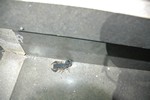
Sunday - DEC 01 2013
Every morning would be sunny.
We were impressed with the location of the property. The location is 09'58.02 N 084'26.11 W (about as far west as the border between Ohio
and Indiana) and the elevation was 1,018 meters (3,343 feet). This was almost 800 feet higher than where we rented in April. We would
discover that being at the end of the rainy season and on the western end of the central valley that the elevation would make a big difference
in the temperature of the properties.
The waters of the Golf de Nicoya ranged from 30 kilometers (19 miles) to 55 kilometers ( 35 miles) away.

We could see Puntarenas (Pointsands, from "punta arenas", or "sand point" in Spanish) (above and to the left of the date stame number 12) on clear days and at night. Its the capital and largest city in the Province of
Puntarenas, on the Pacific coast of Costa Rica. The eponymous and oddly shaped province has its largest section in the South, far from the capital.
Situated at the end of a sandy peninsula (8km long but only 100m to 600m wide), Puntarenas is just 110km west of San Jose by paved highway. The city has 60 calles
(streets) running north to south, but only five avenidas (avenues) running west to east at its widest point. As in all of Costa Rica, street names are largely
irrelevant, and landmarks are used for orientation.

House with a rather large wall that we could see from our place

Blue-and-white swallow drinking from the pool
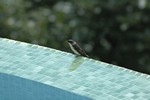
Microwave in spanish - Cool

Views of the property - This house is very impressive the way it's on the hilltop location, very secure.
Looking down the short but steep driveway

Looking up to the carport area

The road from the house

Street views. The gate, across the street views of the central valley and Volcan Poas in the clouds




The gardener's house is right behind the gate.

Since we would not get the rental car till Monday, we walked to the main road (CR-3) appx 500 meters. Someone along the road had his horse
parked in front of his house. We would see this horse all the time during our stay here. Up on CR-3 it was easy to know where to turn as it
was marked with the Barroeta sign. We never did drive to the end, as the road got bad a few miles past our place. Also, the sign listed
a B&B back our road.


MOVIE - 11 meg Lunch down the street at the small restaurant.
Along our road and most every farm we would pass had these types of cattle. They are the Brahman or Brahma, which is a breed of Zebu cattle.
Brahman cattle are known for their extreme tolerance to heat and are widespread in tropical regions. They are resistant to insects
due to their thick skin. Brahman cattle live longer than many other breeds




So we walked the other way on our road. We have a cell & internet tower next to our property. This was not the tower that our internet service came from.

As we walked our views to the SE got better. We never did ride up here at night. We should have.
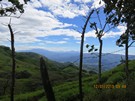
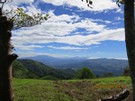


Some nice & secure properties along this road. They even had cameras watching the road along their fence



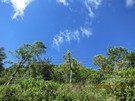
Looking back at the Pacific

Thunderstorm - we never did get rain at our place just clouds

Clouds coming in for the sunset





Looking at the lights of Puntarenas appx. 45 Kilometers (28 miles) away (above and left of the 12 in the date code)

Pool, hot tub and the outside kitchen

This was one of the most interesting critters we saw. Small Amblypygids are also known as whip spiders and tailless whip scorpions
(not to be confused with whip scorpions that belong to the Arachnid order Thelyphonida). The name "amblypygid" means "blunt rump", a
reference to a lack of the flagellum ("tail"). They are harmless to humans. Amblypygids possess no silk glands or venomous fangs.
They rarely bite if threatened, but can grab fingers with pedipalps, resulting in thorn-like puncture injury.
Some species of Amblypygi, particularly Phrynus marginemaculatus and Damon diadema, may be among the few examples of arachnids that
exhibit social behavior. Research conducted at Cornell University suggests that mother amblypygids communicate with their young with
her anteniform front leg, and the offspring reciprocate both with their mother and siblings. Further, the whip spiders would seek each
other out and gather into a group when placed in an unfamiliar environment.
Amblypygids will consume any appropriately sized prey. Most of their diet likely consists of insects. Like many opportunistic predators,
amblypygids and can go for two or three weeks without food. If the animal is molting, ready to molt, or has just molted, they generally
do not feed. Like any other arachnid, an amblypygid will molt several times during its life.
We would see this guy every night in roughly in the same area.


Strange cricket looking thing.

Monday - DEC 02 2013
More property views. Today we go and pick up the rental car.
Blue-grey Tanager (Thraupis episcopus) -- is a medium-sized South American songbird of the Tanager family, Thraupidae. Its range is from
Mexico south to northeast Bolivia and northern Brazil, all of the Amazon Basin, except the very south.

Security wall not very attractive but necessary

Various views
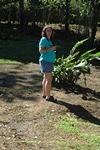
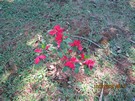

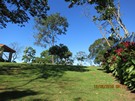

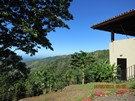

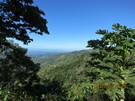
Volcano Poas without a cloud


Dogs laying on the road. They won't get up so you have to drive around them
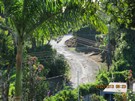

Coffee on the property





Cruise ship in Puntarenas today.

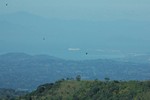
Pineapple growing right on the property
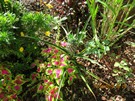
Some type of unknown tree frog



The park from the church in Atenas. And one of the old Toyota pickups.

Atenas cemetery



Restaurante El Mirador (located at 10.0031N 84.3933W) Ken's favorite local restaurant.


Tuesday - DEC 03 2013
So, our first full day with the car. We headed off to the beach.
Tarcoles River Bridge
The CR34 road bridge crosses the Tarcoles River with its reptilian inhabitants frequently seen sunning themselves along the sandbanks.
The crocodiles attract many onlookers pausing to peer down from the bridge. I doubt that this would be allowed in the states as its rather dangerous.
Trucks, people riding horses, no sidewalks and if you fell off the bridge I doubt that it would be good. Nerveless, a very cool place which is free.
Also, we can actually see this bridge area from our house 26km (16 miles) away.
The Tarcoles River, also called the Grande de Tarcoles River or the Rio Grande de Tarcoles, in Costa Rica originates on the southern slopes of the Cordillera
Central volcanic range and flows in a south-westerly direction to the Gulf of Nicoya. The river is 111 km long and its watershed covers an area of 2,121 sq km,
which encompasses around 50% of the country's population.
The river is the most contaminated river in Costa Rica, carrying much of the sewage from the central towns and cities. The river's watershed drains approximately
67% of Costa Rica's untreated organic and industrial waste and is considered the most contaminated river basin in the country.



MOVIE - 24 meg Crocodiles from bridge
This guy on the horse ran across the bridge quickly I assume to avoid any trucks. Would not be a good place to be on a spooked horse.



MOVIE - 5 meg Guy on horse running across bridge
More Crocodiles from the CR34 bridge.

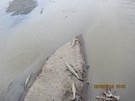



Interesting layers. This area sees considerable flooding in the rainy season

Jaco, Costa Rica
Jaco is a resort city on the Pacific Coast of Costa Rica in Central America. Located in the county of Garabito in the Puntarenas province, Jaco is approximately
two hours by car from the capital San Jose and Costa Rica's primary International Airport (SJO). The Manuel Antonio National Park is located just an hour or two south
of Jaco. The city has a population of approximately 10,000 residents. Jaco's beach is 2.5 miles (4 km) long and offers some of the best surfing in Costa Rica.
It's a nice place but a little too much like a USA costal resort.



Along the dirt road to Playa Hermosa. We think that this area is all part of a national wildlife refuge.
The Northern Jacana is a wader which is a resident breeder from coastal Mexico to western Panama, and on Cuba, Jamaica and Hispaniola. It sometimes breeds in
Texas, USA, and has also been recorded on several occasions as a vagrant in Arizona. The jacanas are a group of wetland birds, which are identifiable by their
huge feet and claws which enable them to walk on floating vegetation in the shallow lakes that are their preferred habitat.

Shade cows (Brahman or Brahma)

Some type of hawk

Playa Hermosa Trip #1
Playa Hermosa is a small community of surfer friendly hotels and small restaurants & all accommodations are located beachfront with surf right
out the door. Because the surf in Playa Hermosa is more challenging than nearby Jaco, this area attracts a more experienced surfer.
We drove by a few surfers but saw more fishermen in the surf and a few swimmers.
While looking at some of the surf web pages about Playa Hermosa we saw that a rouge crocodile lived along this beach a few years ago. It attacked
a person and almost bit off their leg. It was relocated by a bullet to the head. Looking back we did not even think of being alert here with all
the down trees and other wood on the beach. We need to be more alert in the future.

Shade for the car

Various beach views





It's alive. We moved it up where it could grow.


So we were enjoying the beach and could see this guy coming towards us on a horse. At this time we did not know where we were so
I was assuming that this was a park ranger coming to collect a fee. He introduced himself and he runs a horseback riding company.
I am always impressed how every Tico seems to have a business. In the states we have lost that drive and I assume government regulations did that.
We will take him upon his offer on our next trip. I scanned his business card.



Many iguanas here


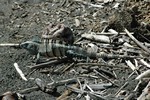

We then ate at Rancho Colon for lunch (truck Stop) for lunch just south of here on CR34. It was actually not bad food and Monika and I had fresh fish.
On the way back we stopped at the Carara National Park parking area just below the Tarcoles River Bridge. Saw a toucan here.
This is not a safe place to leave your car and the tour operators pay guards to watch the customer cars. We enjoyed the area but never
went out of view of the vehicle. We would be back here in a few days on a tour.


Wednesday - DEC 04 2013
Today We got an early start to head to Parque National Volcano Poas as the park opens at 8 and we had to beat the clouds. Generally after
noon you can't see anything. We were here in the spring and the weather was ok but lots of clouds.
So, the first thing was to look and see if it was clear. This was Volcano Poas from the house. The only cloud was from the volcano itself.

What the non-resident tickets into the park looks like. $10

The entrance sign. And arrived before the park opened. Still clear

Poas is an active stratovolcano in central Costa Rica. It has erupted 39 times since 1828. There are two crater lakes near its summit.
The northern lake, Laguna Caliente ("hot lake"), is one of the world's most acidic lakes, with a pH of almost 0 and little or no aquatic
life. Lake Botos, the southern lake, fills an inactive crater and is cold and clear; it is surrounded by a cloud forest within
Poas Volcano National Park.
Poas was near the epicenter of a 6.1-magnitude earthquake in January 2009 that killed at least forty people and affected Fraijanes,
Vara Blanca, Cinchona (the most affected area), the capital San Jose, and the Central Valley region of Costa Rica. There was also
eruptive activity in 2009, involving minor phreatic eruptions and landslides within the northern active crater. Poas eruptions often
include geyser-like ejections of crater-lake water.
We lucked out. Very clear.








Ken looking for Arenal Volcano which can be easily seen from here. No luck. The clouds were just to the north


MOVIE - 14 meg Poas views
Information about the crater.

My favorite sign - Always go to the visitor center! (2,574 meters = 8,356.3 feet)

With it so clear we could see the Caribbean coast which was only 88km (55 miles) away. This area that we could see was just south
of the Costa Rica / Nicaragua border.

More photos. We may never see it this clear here again








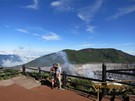
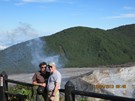
Something blooming

The hike up to Laguna Botos
So we went for a hike to Lake Botos, the southern lake, which fills an inactive crater and is cold and clear; it is surrounded by a cloud
forest within Poas Volcano National Park. The trail was steep and the elevation close to 9,000 feet did not help with hiking. But it
was nice and cool in the lower 60's.




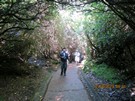
Another funny sign. Stay calm as we all know volcanos don't like screaming.

Laguna Botos





Hiking from Laguna Botos back to the visitor center


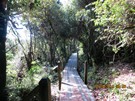


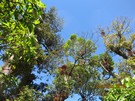
Melastoma of the Volcanoes, Monochaetum vulcanicum, abundant shrub at Poas.

Interesting use of old tires
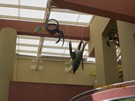
Views along the road from the volcano. This is a very different area than most of Costa Rica. Strawberry farms everywhere and they
must grow year round. Some pine trees and very green.

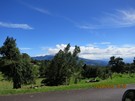
Downtown San Jose


Nice night. Watching the moon set over the Nicoya Peninsula


Looking east into the Central Valley

Orion (constellation) and looking south. So nice to be out in December looking at the stars and not freezing!


So the Wednesday night "what new bug" watch has started. I am sure that the gardener must had wondered what the heck we were doing every night
shining flashlights on all sides of the house.
Tarantula


Another Solifugae and this one was bigger

Huntsman Spider - Almost hand size
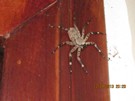
Monika & Mary playing the find game

This is a guess: Emerald glass frog

Thursday - DEC 05 2013
This was a stay around the house day.
Mary and Monika birdwatching

Cruise ship day in Puntarenas

Great Kiskadee
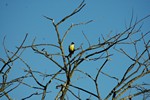
Fog in the Tarcoles River valley where the crocodiles are.

Keel-billed toucan in the tree behind the house. Very cool. Other birds we saw from the house, but didn't photograph, included
the fiery-billed aricari, motmots, hummingbirds, a flock of green parrots, Montezuma oropendola, summer tanagers and rufous-naped wrens.

Various plants
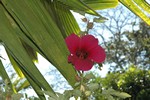


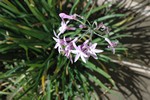
Nice and sunny at 6:49 AM


Colorful bug (dead)

Was sad to see that two Central American Giant Cockroach, (Blaberus giganteus) had drowned in the pool overnight. Ken tried to
give them CPR but they were too far gone. We kept them by the pool for a day or two and they disappeared. We assume the pool cleaning
guy must have figured we were nuts to save them.

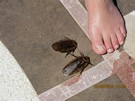
Nice and sunny. Too bad the darn pool was cool. Would drop into the mid 70's over night

We wanted to buy more coffee from El Toledo Coffee but really did not want the full tour like the last time. Since Monika & Dave had not
seen the place I emailed to see if we could come up later in the day just to look at the cool place and to buy coffee. They invited us up and we
spend a couple of excellent hours with them watching them roast beans and sample the different roasts.
Again, this is a must see if you are in the area. They take great pride in what they do and it's excellent coffee!
The plantation is a few miles west of Atenas (located at 9.9969N 84.4295W)
They have a web page at: El Toledo Organic Coffee Tour
Coffee roasting
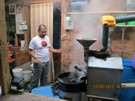
Young girl staying at the plantation with her pet chicken. Her family was from Minnesota and were in Costa Rica doing mission work.

Thursday night bug watch was slow. Only a trantula (then again we may not have looked that hard)

Clear night. The moon and Venus setting
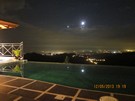
Friday - DEC 06 2013
This was a big day as Marian set up a guide that we used in April at Carara National Park and a Crocodile Tour reserved with Jungle Crocodile Safari.
Carara National Park
Carara National Park is a National Park in the Central Pacific Conservation Area located near the Pacific coast of Costa Rica. It was established
on April 27, 1978 as a biological reserve, but its growing popularity after 1990 forced the government to upgrade its category to national park
due to the massive numbers of tourists who visited it. This change took place in November 1998.
Carara National Park contains more primary rainforest than the relatively close Manuel Antonio National Park. As such, it is wetter than the more
popular Manuel Antonio National Park, and has denser tree growth and more mosquitoes and other insects. This environment makes Carara a haven for
many bird species, being the park a popular birdwatching destination. In addition to Scarlet Macaws, birds found in Carara include orange-chinned
parakeets and other parrots, hummingbirds, woodpeckers, motmots, jacamars, manakins, antbirds, and several species of trogon, including the
black-throated trogon. Several species of water birds inhabit the park as well. These include the anhinga, several species of heron, egret and kingfishers.
Among the reptiles present in the park are the American crocodile and several snake and lizard species. Green and black poison arrow frogs are
among the amphibians present. Mammals include white-tailed deer, red brockets, collared peccaries, agouti, kinkajous, white-faced capuchin
monkeys, mantled howler monkeys, Hoffmann's two-toed sloths and brown-throated three-toed sloths. However, mammals can be difficult to see due
to the dense tree cover.
Like back in spring We then went up the road a bit to parking at a trail head. This time we had a guard that stayed behind to watch our car.
The tour we went on was Victor Tours and Antonio was the guide
(We will continue to do this every time we come to Costa Rica)
White or ghost bat

Ocelot tracks -- The ocelot (Leopardus pardalis), also known as the dwarf leopard, is a wild cat distributed extensively over South America
including the islands of Trinidad and Margarita, Central America, and Mexico. It has been reported as far north as Texas. North of Mexico, it is
found regularly only in the extreme southern part of Texas, although there are rare sightings in southern Arizona. Antonio used to be a hunter so
he was excellent in tracking animals.


Various views along the trails


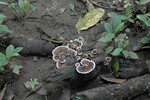




Locally referred to as the carnivorous plant, the Dutchman's pipe vine of Costa Rica (Aristolochia grandiflora) has an exotic and foul smelling flower
with a reputation for eating flies.
The flower blooms for just one day, so it was a bit of a treat to experience it in full blossom. They're big whoppers too, growing up to 20cm in diameter.
Folklore notwithstanding, in fact the Dutchman's pipe only lures flies into its innermost chamber in order to help with pollination.


Chestnut Mandibled Toucan -- It is the second largest of all toucans, weighing in at around 600 grams, with a beak length reaching
eight inches. It is fairly common in captivity, because it is relatively easy to breed, very hardy, and easy to manage. Toucans are
frugivorous birds, whose primary diet are fruit, but supplemented with lizards, snakes, and nestling birds.


The Boat-billed Heron (Cochlearius cochlearius) - colloquially known as the Boatbill - is an atypical member of the heron family.
It lives in mangrove swamps from Mexico south to Peru and Brazil. It is a nocturnal bird, and breeds semi-colonially in mangrove trees,
laying 2-4 bluish white eggs in a twig nest.

Howler monkey


The proboscis bat (Rhynchonycteris naso) is a bat species from South and Central America. Other common names include sharp-nosed bat, Brazilian
long-nosed bat and river bat[. Proboscis bats live in groups. The colonies are usually between five and ten individuals, and very rarely exceed forty.
The bats are nocturnal, sleeping during the day in an unusual formation: they lay one after another on a branch or wooden beam, nose to tail,
in a straight row.



Enlarged. Notice the zig-zag pattern on their backs

The variegated squirrel is a tree squirrel that makes its home in southern Mexico and Central America, from the Chiapas region in the north to
Panama in the south. It can be found in both wet and dry tropical forests, but prefers drier deciduous or mixed forests, scrubland, and even
agricultural land.
This is one of the most beautiful, colorful squirrels of the Americas. There are fourteen different subspecies of the variegated squirrels, which
display a wide variety of color patterns. The back ranges from black to reddish brown or gray, and the underside from white to cinnamon buff. A fairly
large tree squirrel, the head and body length is up to around 13 inches, with the long bushy tail measuring more than 12 inches. The variegated squirrel
can weigh up to around two pounds.

White-Faced/Capuchin Monkey (Mono Cariblancos/Capuchinos) Females have one baby every one to two years. The main predators are large raptors,
boa constrictors, and cats. This is the most likely mammal you will find in Costa Rica. The males are larger than the females.



Unknown bird


MOVIE - 13 meg Looking at the trees

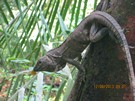
Various views along the trails




Violaceous trogon
It is a resident of moist tropical forests, where it nests in a wasp, ant or termite nest or a hole in a rotten tree, with a typical
clutch of two or three white eggs.
Violaceous Trogons feed on insects and small fruit, and their broad bills and weak legs reflect their diet and arboreal habits.
Although their flight is fast, they are reluctant to fly any distance. They typically perch upright and motionless.

Iguanas back at the main parking area

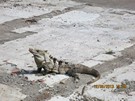





All the various organizations that paid for the crapper

Welcome to Carara's Universal Trail - Encounters Between Worlds - We did not take this back in the spring. Looked very new.
I left the code photos as my phone would read them off of the screen










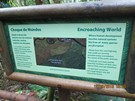







MOVIE - 24 meg Leaf cutter ants









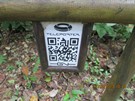
Leaf cutter ants

More hornets

Ox cart hauling gravel along the road on the drive over to Jungle Crocodile Safari


Jungle Crocodile Safari
We wanted to see the crocodiles near the mouth of the Rio Grand de Tarcoles. We went with Jungle Crocodile Safari.
Like in April, we had darn near the entire boat to ourselves and the trip was excellent. The office was located at 9.7775N 84.6263W and the boats were a short walk away at
9.7787N 84.6259W.
The brochure


Like before, we went up the river and then back down past the docks, and up into the mangrove areas.



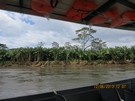

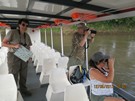
MOVIE - 23 meg Calling in the crocodiles
We lucked out. They called this one Osama bin Laden and said it was the biggest on the river (We assume the story changes)
Like before, the guy goes out and feeds them. We assume that since they are fed every day they are not that aggressive. Still I would
not attempt this.
I asked where Obama crocodile was and they said he was small and hiding. Was told that Hillary crocodile was the ugliest on the river (I can believe that)




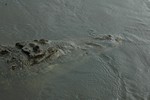



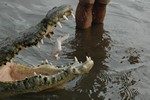



Bare-throated Tiger Herons display an interesting courting behaviour. According to observations in the wild the courting birds face
each other with necks and bodies horizontal and feathers fluffed up, like gamecocks spoiling for a fight, one of them then advances a
few steps, at the same time raising bill and neck vertically and emitting some hoarse roars, before retreating to its first position.
The second bird remains motionless but mimmicks the other's body movements and calls as if hypnotized.



MOVIE - 24 meg Boat moving - Going past Hillary





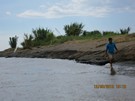
Crocodile, great blue heron and black necked stilts in close proximity.




Green heron


Cattle egrets
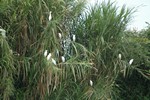

Yellow-headed caracara. The Yellow-headed Caracara is a small, pale caracara of open habitats in lowlands from Costa Rica south to
northern Argentina and Uruguay. It is mostly buffy-yellow, with a narrow dark eye line, dark brown upperparts, and dark brown banding
on the tail. It inhabits agricultural land, grassland, savanna, marshes, and, particularly in Amazonia, successional growth along river
courses. It feeds on an assortment of items including carrion, arthropods, amphibians, and fruit, frequently feeding on the ground
alone or in small groups. The stick nest is constructed high in a tree, or on the ground where trees are unavailable. Anhinga in second photo.


Black necked stilts, great blue heron and white ibis


Caiman along the river
Caimans are alligatorid crocodylians within Caimaninae. The group is one of two primary lineages within Alligatoridae, the other being
alligators. Caimans inhabit Central and South America. They are relatively small crocodylians





Mangrove crab


On to part 2 -- Playa Hermosa, Grecia, Sky walk, at Villa Lapas, Parque National Manuel Antonio
Costa Rica adventure - December 2013




























































































































































































































































































































